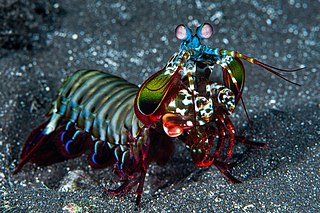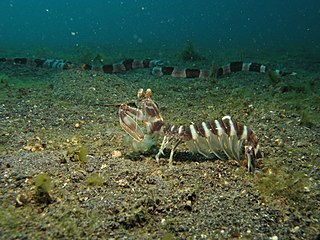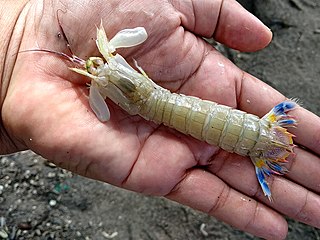
Odontodactylus is a genus of mantis shrimp, the only genus in the family Odontodactylidae. Mantis shrimp of the genus Odontodactylus can not only detect circular polarisation of light, but can also detect polarised light reflecting off their telson and uropods.

The Lysiosquillidae or banded mantis shrimps are a family of mantis shrimp, comprising some of the largest known mantis shrimp species. The most common and best known species is Lysiosquillina maculata, the zebra mantis shrimp.

Squilla mantis is a species of mantis shrimp found in shallow coastal areas of the Mediterranean Sea and the Eastern Atlantic Ocean: it is also known as "pacchero" or "canocchia". Its abundance has led to it being the only commercially fished mantis shrimp in the Mediterranean.

Squillidae is a family of mantis shrimp, the only family in the superfamily Squilloidea. The type genus is Squilla. It is the stomatopod family with the most genera, as follows:

Eurysquillidae is a family of mantis shrimp. Formerly placed in the superfamily Gonodactyloidea, it has since been recognised that eurysquillids are closer to families in the Squilloidea, and so Eurysquillidae has been placed in its own superfamily, Eurysquilloidea. The family was first described in 1977 by Raymond Manning.
Platysquilla eusebia is a species of mantis shrimp in the family Nannosquillidae, from the Mediterranean Sea and north-eastern Atlantic Ocean. It is a spearer, and grows up to 7 cm (2.8 in) long.

The Processidae are a family of shrimp, comprising 65 species in five genera, and the only family in the superfamily Processoidea. They are small, nocturnal animals, mostly living in shallow seas, particularly on grass flats. The first pereiopods are usually asymmetrical, with a claw on one, but not the other. The rostrum is generally a simple projection from the front of the carapace, with two teeth, one at the tip, and one further back.
Tetrasquillidae is a family of mantis shrimp containing ten genera:
Gonodactylellus is a genus of mantis shrimp. The genus was first described by Raymond Manning in 1995.

Bathysquillidae is a family of mantis shrimp. It contains two genera and three species. The family was described by Raymond Manning in 1967.

Acanthosquilla derijardi is a species of stomatopod crustacean. Its distribution is widespread throughout the Indo-West Pacific. The species was initially described by the American carcinologist Raymond B. Manning in 1970. Its junior synonym, A. sirindhorn, was named in 1995 in honor of Princess Sirindhorn of Thailand.

Gonodactylus chiragra is a medium to large mantis shrimp that is distributed widely throughout the West Indo-Pacific.

Oratosquilla is a genus of crustaceans belonging to the family Squillidae. The species of this genus are found in Indo-West-Pacific. The genus was first described in 1968 by Raymond Brendan Manning.

Erugosquilla is a genus of crustaceans belonging to the family Squillidae. The genus was first described in 1995 by Raymond Brendan Manning. The type species is Erugosquilla massavensis(Kossmann, 1880).
Erugosquilla septemdentata is a species of shrimp in the family, Squillidae, and was first described in 1994 by Shane T. Ahyong as Oratosquilla septemdentata. The name was revised to Erugosquilla septemdentata in 1995 by Raymond B. Manning.
Shane Timothy Ahyong is an Australian zoologist specialising in marine invertebrates. Since 2010 he has worked as a senior principal research scientist at the Australian Museum. Following his Ph.D. he worked as a post-doctoral researcher at the Australian Museum and in 2006 left to manage Marine Biodiversity and Biosecurity Group and Marine Invasives Taxonomic Service within the National Institute of Water and Atmospheric Research in New Zealand.

Acanthosquilla crosnieri is a species of stomatopod crustacean in the Nannosquillidae family. It has been found in waters off the Marquesas, at depths of 0 - 100 m but more usually at 7 - 25 m, and was first described by the Australian carcinologist Shane T. Ahyong in 2002.
Alima neptuni is a species of shrimp in the Squillidae family, and was first described in 1768 by Carl Linnaeus as Cancer neptuni.
Alima maxima is a species of shrimp in the Squillidae family, and was first described in 2002 by Shane Ahyong.
Acanthosquilla melissae is a species of stomatopod crustacean in the Nannosquillidae family, and was first described by the Australian carcinologist Shane T. Ahyong in 2007.













